Embracing virtual working to keep brands fit: 13th Annual Research Paper
Our 13th annual research project explores the impact of the Covid-19 crisis on brand strategy. Lots of research has been published about cuts in marketing investment, but what about the fundamental foundation of brand strategy: has investment here suffered the same cuts?
Our research surveyed 100+ senior marketing professionals across regions and sectors. We also surveyed 400 UK consumers about switching of buying habits during lockdown.
1. Brand strategy more important than ever
The seismic shock of Covid-19 requires urgent short-term tactical responses. At the same time, 97% agree it’s important to keep working on brand strategy to be in good shape post-crisis.
Strategic priority one is growing the core (67% rating very important). Radical changes to the core may be needed for the 36% of companies in our survey suffering significant or potentially fatal declines. Uber, for example, is “re-focusing on its core ride-hailing and food delivery businesses.”
For the 22% lucky enough to see business growth, the challenge is responding to increased demand. Online card and gifting brand Moonpig.com, for example, has quickly updated its core product offer, with new ‘Stay at Home’ cards already 10% of sales, and changed its 24hr delivery promise to 5-7 days, to manage supply chain issues.
Brand positioning is also a fundamental strategic priority, including reviewing the role of social mission. Now is a good time to ensure your positioning is razor sharp. For example, Uniqlo sharpened its positioning to survive Japan’s great recession: from a discount retailer to an innovator in high-quality clothing at reasonable prices. The challenge here is balancing freshness and consistency, which will vary by category and brand:
• Consistency: attributes and brand properties which made the brand famous and remain relevant.
• Freshness: changes in positioning to reflect ‘the new normal’.
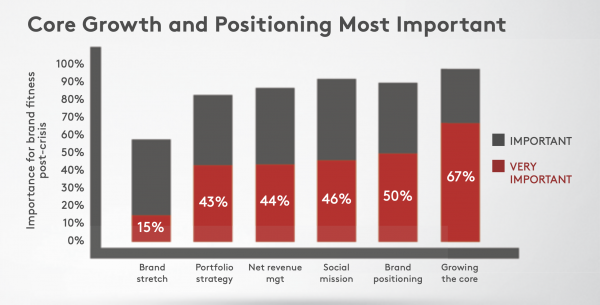
2. Consumer insight key to keep up with changes
50% of companies surveyed need completely new insight work. In a recent post here we suggested exploring three areas:
HOW = shopping behaviour: instant and radical changes in behaviour provoked by Covid-19 include switches where the ‘tap’ of supply has suddenly been turned off (e.g. switching from dining out to ordering more take-away food). 34% of UK consumers have switched across the four categories in our new study (see graph below), with levels of satisfaction likely to impact the chances of demand ‘snapping back’ post-lockdown:
– Gyms: higher chance of snap-back? 25% have switched from gyms to to online fitness, with 16% satisfied but 9% dissatisfied (net +7). The challenge here will be meeting hygiene and social distancing requirements without cutting capacity below profitable levels.
– Cinema: lower chance of snap-back? A higher 40% have switched to online movies with most satisfied (net +32), helped by early online release of big movies and cost savings. The challenge here is selling experiential benefits to get people off their sofas and visiting again.
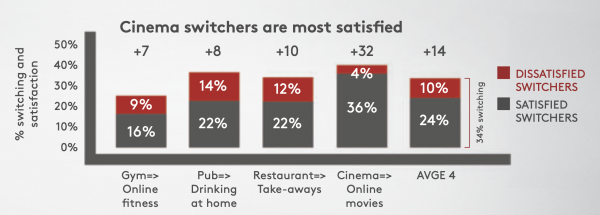
WHY = Values and needs: For example, will holiday makers be emotionally scarred by Covid-19, and prioritise safety over adventure? In fact, mainstream consumer values were largely unchanged in April 2020 vs. July 2018 in a study by Reach Solutions, showing how brands need to avoid ‘knee-jerk’ changes. Instead, brand teams need to find the right balance of freshness and consistency.
VALUE: Price and promotion vs. quality: all brands needs to prepare for a severe post-Covid recession. This may require a fine-tuning of brand positioning, as was the case with work we did with Sainsbury’s after the financial crash in the late 2000’s. The brand idea evolved from being focused on experimentation, “Try something new today”, to more of balance between enjoying life and saving money: “Live Well for Less”. This inspired business building initiatives such as ‘Feed your family for a fiver’ and Brand Match.
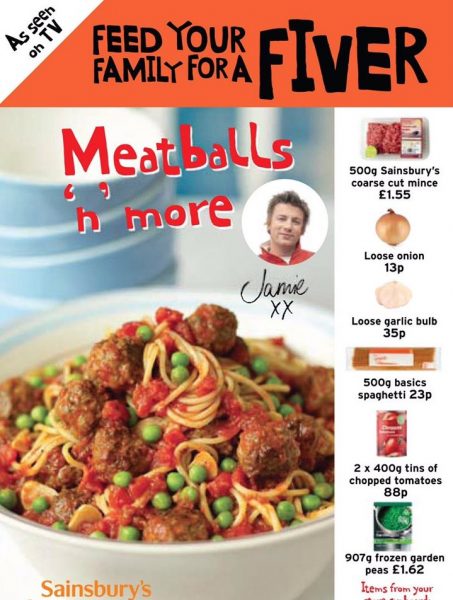
3. Brand strategy work stopped by some
Although 97% agree its important to maintain brand strategy during this crisis, as seen above, almost 1/3 of companies have stopped/paused some or all brand strategy work. “Our brand planning usually starts in April but is on hold,” commented one respondent. This does mean a significant number of companies risk compromising the future fitness of their brands. We recommend following the example of the companies continuing brand strategy work as planned, or even using this time as an opportunity to start new work.
Some cutbacks in brand strategy reflect prioritisation of tactical initiatives to protect short term sales. Whilst we appreciate the pressure brand leaders are under, unless the business is in danger of extinction (only 2% of our survey), this does seem short sighted. Cuts also reflect concerns about the ability to do quality brand strategy work in a socially distanced world, where teams can’t physically collaborate. Here, smart process design and expert facilitation can go a long way to addressing these concerns, as we’ll see below.
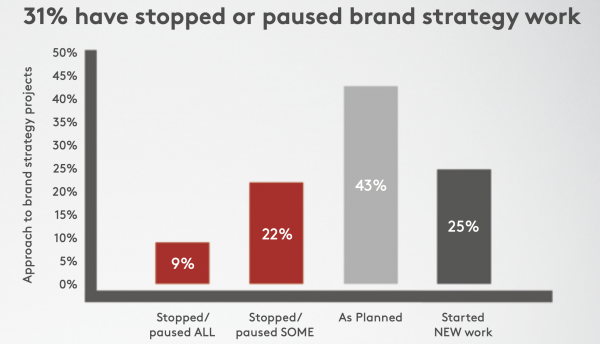
4. Online brand fitness programs
The crisis has triggered a sharp increase in demand for online fitness at home: Google searches for online fitness programs are up +400% and the stock price of smart exercise bike brand Peloton is up 95%. Our study shows a similar online transformation is underway for brand strategy work.
An increase in online qual/quant research during the crisis (+44 %/+32%) probably represents late adopters catching up, as research has been moving online for a while. Our own brandgym projects, for example, use a ‘curated’ collection of online insight tools, such as mobile ethnography and AI-enabled cultural analysis. More significant, in our view, is the move of collaboration online, with +41% doing virtual brand strategy workshops.
Encouragingly, virtual brand workshops are at least 70-80% as effective as face-to-face for 62% of respondents. However, a minority (14%) do rate them as poor, with challenges including engagement, collaboration and creativity. However, based on our research, and experience from multiple virtual projects, these challenges can be largely addressed with smart process design and expert facilitation: see below for a summary of learning on what it takes to design and deliver an effective virtual brand strategy project.
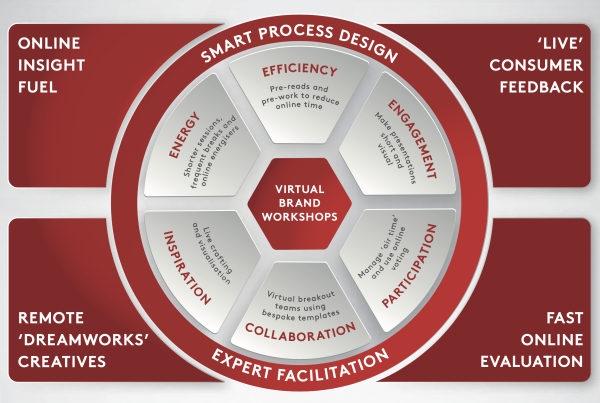
In conclusion, assess your brand’s fitness for now and the future, using existing and new insight, and find the right balance of freshness and consistency. Maintain or enhance your brand strategy program, avoiding the temptation to focus on short-terms tactics only, using smart design and facilitation to deliver effective virtual brand strategy projects for today’s socially distanced world.
For more on virtual workshops, see this other post.


